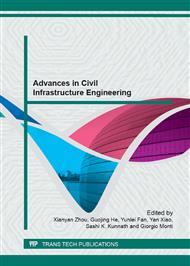p.382
p.389
p.394
p.399
p.404
p.411
p.417
p.423
p.429
Study on Preparation of High Early Strength Recycled Aggregate Concrete
Abstract:
An orthogonal experimental design method was adopted for the mix design of high early strength recycled aggregate concrete (HSRAC), and the influence of water-binder ratio, percentage of recycled aggregate(RA)and highly active compound mineral admixture (HACMA) content on the strength of the concrete was discussed. The test results indicated that water-binder ratio was the most principal and significant influencing factor on the strength of HSRAC, regardless of age. An empirical relationship among the strength of HSRAC, the water-binder ratio, the percentage of recycled aggregate and HACMA content was proposed by using multivariate regression analysis. The demand of opening heavy or heavier traffics and rapid repair concrete on strength to HSRAC could be all met.
Info:
Periodical:
Pages:
404-410
Citation:
Online since:
January 2013
Authors:
Price:
Сopyright:
© 2013 Trans Tech Publications Ltd. All Rights Reserved
Share:
Citation:


